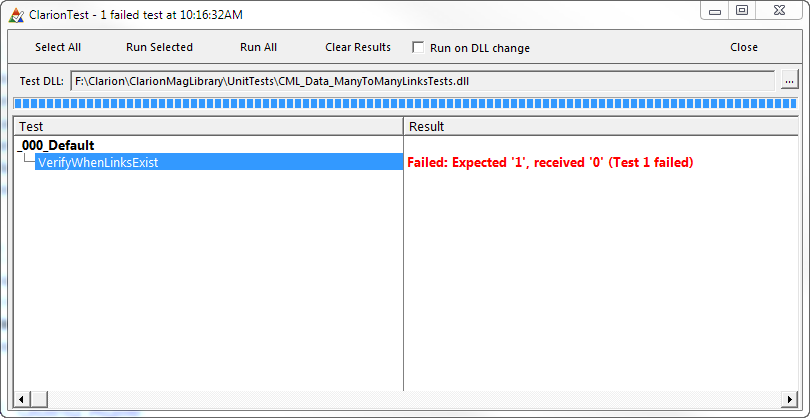...
I create the class using John Hickey's excellent ClarionLive! Class Creator, part of the ClarionLive! Utilities:
I've defined my baseline class that uses the CML conventions. It's included in CML as CML_BaseClass.inc and CML_BaseClass.clw.
...
At the risk of repeating myself even more than usual, one of the things I like best about test-driven development is it forces me to think about how I want to use my classes long before I think about how to write them. And that's almost always a more productive approach.
I see CML_Data_ManyToManyLinks as my repository of information about whether any two records from each of two files linked. As with the original class that is the inspiration for this series, I'm going to use the arbitrary terms "left" and "right" to define those two records.
Let's say I have "left" file records A, B and C, and "right" file records X, Y and Z.
A is linked to X and Z, and C is linked to Y and Z. B is linked to none of the right records.
I'll need a way to store the links in CML_Data_ManyToManyLinks and a way to query CML_Data_ManyToManyLinks to find out if a link exists.
Now I can start writing some code. Here's my first test procedure's data section:
| Code Block |
|---|
ManytoMany CML_Data_ManyToManyLinks
itemize(),pre()
LeftRecordA equate
LeftRecordB equate
LeftRecordC equate
RightRecordX equate
RightRecordY equate
RightRecordZ equate
end |
And here's the code:
| Code Block |
|---|
ManyToMany.AddLink(LeftRecordA,RightRecordX)
ManyToMany.AddLink(LeftRecordA,RightRecordZ)
ManyToMany.AddLink(LeftRecordC,RightRecordY)
ManyToMany.AddLink(LeftRecordC,RightRecordZ)
AssertThat(ManyToMany.HasLink(LeftRecordA,RightRecordX),IsEqualTo(true), 'Test 1 failed')
AssertThat(ManyToMany.HasLink(LeftRecordA,RightRecordY),IsEqualTo(false),'Test 2 failed')
AssertThat(ManyToMany.HasLink(LeftRecordA,RightRecordZ),IsEqualTo(true), 'Test 3 failed')
AssertThat(ManyToMany.HasLink(LeftRecordB,RightRecordX),IsEqualTo(false),'Test 4 failed')
AssertThat(ManyToMany.HasLink(LeftRecordB,RightRecordY),IsEqualTo(false),'Test 5 failed')
AssertThat(ManyToMany.HasLink(LeftRecordB,RightRecordZ),IsEqualTo(false),'Test 6 failed')
AssertThat(ManyToMany.HasLink(LeftRecordC,RightRecordX),IsEqualTo(false),'Test 7 failed')
AssertThat(ManyToMany.HasLink(LeftRecordC,RightRecordY),IsEqualTo(true), 'Test 8 failed')
AssertThat(ManyToMany.HasLink(LeftRecordC,RightRecordZ),IsEqualTo(true), 'Test 9 failed') |
Here's the most important bit: I haven't written the class code yet!
Step one, then, is to write the idealized unit test.
I do have an empty class on hand, so I need to include that globally:
When I compile I get a bunch of errors about the missing methods:
The next step is to create stub methods so everything compiles:
Here's the class header:
| Code Block |
|---|
include('CML_IncludeInAllClassHeaderFiles.inc'),once
CML_Data_ManyToManyLinks Class,Type,Module('CML_Data_ManyToManyLinks.CLW'),Link('CML_Data_ManyToManyLinks.CLW',_CML_Classes_LinkMode_),Dll(_CML_Classes_DllMode_)
Construct Procedure()
Destruct Procedure()
AddLink procedure(long leftRecordID,long rightRecordID)
HasLink procedure(long leftRecordID,long rightRecordID),bool
End |
And the methods:
| Code Block |
|---|
CML_Data_ManyToManyLinks.Construct Procedure()
code
CML_Data_ManyToManyLinks.Destruct Procedure()
code
!dispose(self.Errors)
CML_Data_ManyToManyLinks.AddLink procedure(long leftRecordID,long rightRecordID)
code
CML_Data_ManyToManyLinks.HasLink procedure(long leftRecordID,long rightRecordID)!,bool
code
return false |
Now the unit test app compiles, but the test fails:
All I need to do now is write the minimum code necessary to get the code to pass.
It isn't possible to declare an actual queue inside a class, so I've created a typed queue and a reference in the class:
| Code Block |
|---|
CML_Data_ManyToManyLinks_DataQ queue,TYPE
LeftRecordID long
RightRecordID long
end
CML_Data_ManyToManyLinks Class,Type,Module('CML_Data_ManyToManyLinks.CLW'),Link('CML_Data_ManyToManyLinks.CLW',_CML_Classes_LinkMode_),Dll(_CML_Classes_DllMode_)
LinksQ &CML_Data_ManyToManyLinks_DataQ
Construct Procedure()
Destruct Procedure()
AddLink procedure(long leftRecordID,long rightRecordID)
HasLink procedure(long leftRecordID,long rightRecordID),bool
End
|
The constructor creates and instance of the queue, the destructor empties and disposes of the queue. The AddLink and HasLink methods are almost identical except that one is looking up a record and the other one is adding a record.
| Code Block |
|---|
CML_Data_ManyToManyLinks.Construct Procedure()
code
self.LinksQ &= new CML_Data_ManyToManyLinks_DataQ
CML_Data_ManyToManyLinks.Destruct Procedure()
code
free(self.LinksQ)
dispose(self.LinksQ)
CML_Data_ManyToManyLinks.AddLink procedure(long leftRecordID,long rightRecordID)
code
clear(self.LinksQ)
self.LinksQ.LeftRecordID = LeftRecordID
self.LinksQ.RightRecordID = rightRecordID
add(self.LinksQ,self.LinksQ.LeftRecordID,self.LinksQ.RightRecordID)
CML_Data_ManyToManyLinks.HasLink procedure(long leftRecordID,long rightRecordID)!,bool
code
self.LinksQ.LeftRecordID = LeftRecordID
self.LinksQ.RightRecordID = rightRecordID
get(self.LinksQ,self.LinksQ.LeftRecordID,self.LinksQ.RightRecordID)
if not errorcode() then return true.
return false |
Now my test succeeds:
So far so good. But can I wire this into my UITest program?
That program used this queue declaration:
| Code Block |
|---|
CheckboxQueue queue
Checked bool
CheckedIcon long
CheckedText string(30)
end |
But I'll need another field now, because I need to be able to identify my "right" record in the CML_Data_ManyToManyLinks class:
| Code Block |
|---|
CheckboxQueue queue
Checked bool
CheckedIcon long
CheckedText string(30)
ID long
end |
Now I can declare an instance of that class:
| Code Block |
|---|
Links CML_Data_ManyToManyLinks |
and in the code initialize the queue of data and the linking class separately. If I were using this in a database setting, and using this code to display which classes a student takes, the first loop would be reading the list of potential classes and the second loop would be reading the records that indicate which classes the student actually takes (except that for purposes of demonstration I'm randomly selecting about half of them).
| Code Block |
|---|
loop x = 1 to 100
clear(CheckboxQueue)
!CheckboxQueue.FirstField = x * 10
CheckboxQueue.CheckedText = 'String ' & x
CheckboxQueue.ID = x
add(CheckboxQueue)
end
loop x = 1 to 100
if Random(1,2) = 1
Links.AddLink(x)
end
end
|
But there's something wrong with my code. I only have one parameter to AddLink, not two. This is effectively the "right" side value; there really isn't any particular reason to store the "left" side ID because there is only one record on the left side.
That doesn't mean there's anything fundamentally wrong with the class design; there might be a situation somewhere down the road where I really do want to keep links for multiple left records. But probably most uses of the class will only have one left record and multiple right records.
This also leads me to want some slightly different method names:
- IsLinkedTo(long rightRecordID)
- IsLinkBetween(long leftRecordID,long rightRecordID)
- SetLinkTo(long rightRecordID)
- SetLinkBetween(long leftRecordID,long rightRecordID)
The naming isn't strictly consistent (IsLink vs IsLinked) but I think it's a bit better grammatically.
Next time I'll finish wiring the Links object into my UITest application, which no doubt will lead to some further code changes.





